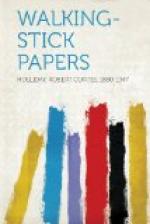Now, there is nothing in all the world quite like art exhibitions. Beyond any other sort of show they possess a spirit which (to use a pet and an excellent critical expression of one of our foremost art critics) is “grand, gloomy, and peculiar.” You feel this charged atmosphere at once at an art exhibition. You walk softly, you speak low, and you endeavour to become as intelligent as possible. Art exhibitions, in short, present various features indigenous to themselves which, so far as I am aware, have not before been adequately commented upon. The principal observations which they solicit are as follows:
First, art exhibitions are attended by two classes of people: very fine-looking people, and funny-looking people. There is a very striking kind of a young man goes to art exhibitions that I myself never accomplish seeing anywhere else, though sometimes I see pictures of him. This young man is superbly patrician. You may have remarked this singular phenomenon. All the young men in all the advertisements in the magazine Vanity Fair are the same young man, whether riding in a splendid motor car, elegantly attending the play, or doing a little shooting of birds. You know him, for one thing, by his exquisite moustache. This fastidiously groomed, exclusively tailored young man, to be seen in the pages spoken of and at art exhibitions, is certainly not of Art, nor is he of business. He takes no account whatever, apparently, of time, as men of business do; and manifestly one could not work in such a moustache and such clothes without mussing them. He is, in fine, of Vanity Fair. Oscar Wilde was, as usual, wrong when he said that all beautiful things were quite useless. This immaculate young man’s practical function at art exhibitions, as perhaps elsewhere, is that of escort.
He is escort to groups of very handsome and very expensive-looking young ladies; and these fragrant, rustling groups, with the waxen, patrician young man in tow, stroll slowly about, catalogues unnoticed in hand, without pause skirting the picture-hung walls. They are very still, and they gaze upon the art that they pass with the look of a doe contemplating the meaning of the appearance of a man. The perfect escorts of these groups, who would seem naturally to be rather gay young men, look very serious indeed. Now one of them gracefully, though as if careful not to make any noise, bends to one of the young ladies; and, indicating by a solemn look one of the paintings, he whispers to her apparently concerning it. She silently nods: it is, evidently, quite as he says. When an art exhibition is so undertakery a thing you wouldn’t think that one would come. Though perhaps it is that one ought.
At any rate, there is quite a turn-out to-day moving beneath the ghostly glow of the shrouded sky-light ceiling. Half the Avenue seems to be here. What a play it is, this highly urban throng! Let us sit here on this divan down the middle of the room. With what a stately march the pictures go in their golden frames along the symphonious, burlap walls! There, by that copious piece of intelligence, Manet’s “Music Lesson,” is—




